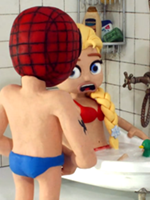Disturbing YouTube videos with famous child heroes
Video platforms such as YouTube are not only popular with young people and adults, because they now also offer a wide range of content that has been produced especially for children and can be accessed free of charge. This includes both informative learning formats and pure entertainment offerings. When choosing a suitable video, however, parents should look very carefully and not be blinded by first impressions. Among the many harmless contents, there are also inappropriate and even developmentally harmful video clips that are supposedly aimed at children.
Much of this content can be found on YouTube with keywords that are intended to suggest children as the target group . For example, the videos are tagged with terms such as "fidget spinner" (a current trend toy among children) or "learn colors. This is also suggested by the choice of protagonists in these videos: "Elsa" from the Disney film "Frozen", the popular character "Peppa Pig", the Marvel characters "Spiderman" and "Hulk" or Batman's opponent "Joker" (DC Comics) appear particularly frequently. If children search for these characters, they might come across these disturbing videos.
In the videos, the protagonists injure themselves more or less severely, play pranks on each other with feces or hint at sexual intentions. The stories themselves often seem aimless and the themes presented are repetitive. Some videos were also shot with real actors in appropriate costumes of the children's heroes. Often, blatant situations are already shown in the preview images, which do not necessarily occur in the video. Partially, however, very brutal videos have harmless thumbnails.
The problem
The videos only give the impression of being aimed at children and the scenes shown are more than unsuitable for children. Due to the tagging with a large number of terms that appear in connection with content that is actually suitable for children, it becomes very easy for children, starting from a harmless video, to become aware of an unsuitable video. Even if children do not click on these videos, the thumbnails alone are often misleading. However, the videos are also problematic because the current role models and heroes of many children are instrumentalized and harmful content is brought to them. The protagonists' behavior shown could also inspire imitation among younger children due to their popularity.
Who is doing this and why?
It is not clear who exactly is responsible for these videos. Several channels exist with such a video offering. What is striking are the extremely high click numbers of the individual videos. It is not clear whether the general intention behind the videos is to specifically lure children to this content. The channel operators have not yet commented. However, it is obvious that the videos are intended to generate as many clicks as possible in order to generate more advertising revenue.
What should parents be aware of?
Anyone who is logged in to YouTube with a user account can use the settings to define which content can be displayed, for example by subscribing to channels with content suitable for children and activating the restricted mode . However, the full range of YouTube videos is accessible again as soon as the user logs out. And this is also possible for children at any time with one click.In addition, given the user-generated content, there is no algorithm capable of reliably filtering out inappropriate content on its own - here, YouTube relies on users to report such videos so that they can be blocked for restricted mode. Until this happens, the videos can still be viewed. Thus, 100% protection for children cannot be guaranteed.Caution with the autoplay function: If a new video starts automatically after a child-friendly video, this does not necessarily have to be child-friendly as well. For safety reasons, the autoplay function can be deactivated.
With YouTube Kids, the platform offers a special app to ensure that only child- and family-friendly content can be played. This has also been available in Germany and Austria since 06.09.2017. The offer is curated both automatically and manually, but even here it can happen that unsuitable videos appear. According to the provider, however, messages on YouTube Kids are to be treated with a higher priority. The app is free and therefore not ad-free, but stricter advertising guidelines apply.
Younger children should generally not be left unsupervised on YouTube, and parents should be within sight and earshot of older children. Unfortunately, when using portals with user-generated content, it can never be completely ruled out that unsuitable content may be hidden among the wide range of useful content. Parents should also carefully select videos and channels that are suitable for children. If necessary, watch the videos in advance without your child. Check who is behind the channel and what advertising is shown there. In the meantime, some TV stations, such as WDR or BR, offer their children's formats on their own YouTube channels and thus provide children with a child-friendly, advertising-free and editorially checked offering on YouTube as well. Since 2013, there has also been Juki, the media education video platform for children. All of the platform's offerings are monitored by media educators and pre-screened by the editorial team. This ensures that all uploaded contributions are suitable for children.
More on the topic
- YouTube Kids - Video offer for children
- YouTube topic area on klicksafe.de
- Guide "Safe on the go on YouTube" (PDF)
- Saferinternet.at: Video guide "Frag Barbara!", episode 1: YouTube - Never without parents
- Motherboard Vice: YouTube phenomenon: Someone is traumatizing children on YouTube with brutal content in their favorite cartoon videos
- digitalparents.at: Link collection - YouTube channels and playlists for kids
- WDR YouTube channel: The show with the elephant
- BR.de: Anna and the checkers - now also on YouTube!
- "Project 11: Creating short films with Juki" in klicksafe work material for elementary school "Through the year with klicksafe"

